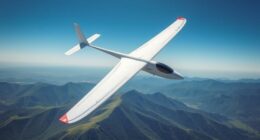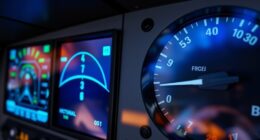As someone who pilots gliders, I’m perpetually in awe of the complex expertise and accuracy needed to securely land a glider.
Did you know that the average glider has a glide ratio of 25:1, allowing it to stay airborne for extended periods?
In this article, I will delve into the techniques and strategies that enable pilots to land gliders with utmost accuracy.
From understanding wind patterns to executing controlled descents, join me on a journey through the fascinating world of glider landings.
Key Takeaways
- Identifying and utilizing thermals play a crucial role in extending flight time and finding suitable landing spots.
- Glide ratio and thermal utilization are essential for successful emergency landings and require continuous training and skill development.
- Wind analysis is of high importance in emergency landing procedures as it determines wind direction and strength, directly impacting the glider’s flight path.
- Weight distribution is crucial for maintaining stability and control during landing, and continuous training is necessary to accurately distribute weight and optimize the glider’s performance.
Understanding Wind Patterns
Understanding wind patterns is crucial for a pilot to safely land a glider. As a pilot, I must have a precise understanding of the different types of wind currents that can affect the flight path of the glider.
One important factor is understanding thermal currents, which are columns of warm air that rise from the ground. By identifying these thermal currents, I can use them to gain altitude and extend my flight time.
Additionally, analyzing wind shear is essential in ensuring a smooth landing. Wind shear refers to the sudden change in wind direction or speed. By carefully studying wind shear, I can adjust my flight plan accordingly and make the necessary adjustments to maintain control of the glider.
Understanding wind patterns, thermal currents, and wind shear allows me to navigate the skies with precision and confidence, preparing me to utilize precise maneuvers during the landing process.
Utilizing Precise Maneuvers
By utilizing precise maneuvers, a pilot can safely bring a glider to the ground. Precision landing techniques are crucial for maintaining control during crosswinds and ensuring a smooth touchdown. Here are three key maneuvers that contribute to a successful landing:
-
Crabbing: When faced with a crosswind, the pilot must align the glider’s heading with the runway by applying a crab angle. This allows the glider to track straight along the runway centerline despite the wind’s lateral force.
-
Sideslip: To counteract the drift caused by crosswinds, the pilot can employ a sideslip technique. By applying opposite rudder and aileron inputs, the glider’s wing is lowered into the wind, generating sufficient drag to counteract the crosswind component.
-
Flare: As the glider nears the ground, the pilot reduces the rate of descent by pulling back on the control stick. This gradual flare maneuver allows for a smooth transition from descending flight to level flight just inches above the ground.
Mastering the flare technique is essential for achieving a precise landing and will be discussed in the next section.
Mastering the Flare Technique
Mastering the flare technique is crucial for achieving a smooth transition from descending flight to level flight just inches above the ground. Flaring is the process of gradually reducing the rate of descent and ultimately leveling the glider for a gentle touchdown.
To execute this technique effectively, the pilot must have a deep understanding of the aircraft’s aerodynamics and possess precise control over the flight controls. Properly timing the flare is essential for landing accuracy, as it allows the glider to touch down with minimal vertical velocity and ensures a smooth landing.
Monitoring Airspeed and Altitude
Monitoring airspeed and altitude is crucial in ensuring a safe and controlled landing. As a pilot, I understand the importance of constantly monitoring these two vital parameters during the landing phase.
By monitoring airspeed, I can ensure that I maintain the appropriate speed for a successful touchdown. This is especially important when considering the effects of wind and weather conditions, which can greatly impact the glider’s performance.
Additionally, monitoring altitude allows me to gauge my progress and adjust my descent accordingly. By maintaining situational awareness, I can make informed decisions based on the current conditions and ensure a smooth and precise landing.
As I carefully monitor airspeed and altitude, I can seamlessly transition into assessing the landing conditions ahead, preparing for a successful touchdown.
Assessing Landing Conditions
Assessing landing conditions is crucial for ensuring a safe and successful touchdown. When preparing to land a glider, I must carefully evaluate the weather conditions and runway length.
Here are three key factors to consider:
-
Weather conditions: I need to assess the wind direction, speed, and any gusts. Crosswinds can make landings challenging, so it’s important to determine if they are within the safe limits for my glider.
-
Runway length: Evaluating the length of the runway is essential to determine if it’s sufficient for a safe landing. I must consider the glider’s approach speed and the distance required to come to a complete stop.
-
Obstacles: Assessing the presence of any obstacles near the landing area is crucial. Trees, power lines, or buildings can pose significant risks and need to be accounted for during the landing process.
Choosing the Right Landing Spot
When selecting where to touch down, it’s crucial to consider factors like terrain, wind conditions, and potential obstacles.
Evaluating the terrain involves assessing its slope, surface composition, and any irregularities that could affect the landing. Smooth, flat terrain is ideal for a safe touchdown.
It’s also important to be aware of potential obstacles such as trees, buildings, or power lines that could pose a risk during the landing. By carefully evaluating these factors, a pilot can identify the most suitable landing spot.
Once the ideal spot has been chosen, executing a controlled descent becomes the next priority. Transitioning smoothly from assessing the landing conditions to executing a controlled descent requires careful planning and precise actions.
Executing a Controlled Descent
After carefully selecting the right landing spot, the next crucial step in landing a glider is executing a controlled descent.
As a pilot, understanding thermals and managing air currents is essential in this process.
Thermals are columns of rising air that can provide lift to a glider, allowing it to stay aloft. By recognizing the signs of thermals, such as cumulus clouds or the behavior of other soaring birds, I can navigate towards them and gain altitude.
Additionally, I need to be mindful of air currents, such as updrafts and downdrafts, which can affect my descent rate. By actively adjusting the glider’s airspeed and using the flight controls, I can maintain a stable and controlled descent towards my chosen landing spot.
Mastering the art of executing a controlled descent is a fundamental skill that sets the foundation for practicing emergency landing procedures.
Practicing Emergency Landing Procedures
Practicing emergency landing procedures is a crucial part of a pilot’s training. It involves learning how to safely and efficiently handle unexpected situations. It is important to be prepared for any potential emergency that may arise during a flight.
When practicing emergency landing techniques, pilots must evaluate potential landing areas to determine the safest option. This evaluation includes considering factors such as the size and condition of the landing area, the presence of obstacles or hazards, and the availability of emergency services. Additionally, pilots must assess the wind direction and speed to choose the most suitable landing direction.
Considering Glide Ratio and Performance
To ensure a safe emergency landing, you need to assess your aircraft’s glide ratio and performance.
Glide ratio optimization is crucial for maximizing the distance you can cover while descending without power. By understanding your glider’s glide ratio, which is the ratio of the distance covered to the altitude lost, you can make informed decisions during an emergency situation.
Additionally, thermal utilization plays a vital role in extending your flight time and increasing your chances of finding a suitable landing spot. By identifying and utilizing thermals, which are updrafts of warm air, you can gain altitude and extend your glide, giving you more time to assess the situation and find a safe landing area.
Considering glide ratio and thermal utilization are essential aspects of emergency landing procedures, ensuring a successful outcome. Continuous training and skill development further enhance a pilot’s ability to effectively assess and utilize these factors in emergency situations.
Continuous Training and Skill Development
By continuously training and developing my skills, I’ll be able to effectively assess and utilize factors like glide ratio and thermal utilization during emergency situations. This allows me to confidently navigate and land a glider in various conditions. Wind analysis is crucial in understanding the direction and strength of the wind, which directly impacts the glider’s flight path. Weight distribution plays a key role in maintaining stability and control during landing. It is essential to ensure proper weight distribution to avoid tipping or stalling the glider. Through continuous training, I learn to analyze wind patterns and adjust my techniques accordingly. Additionally, developing my skills enables me to accurately distribute weight in the glider, optimizing its performance and ensuring a safe landing.
| Factors | Importance |
|---|---|
| Wind analysis | High |
| Weight distribution | High |
| Glide ratio | Medium |
Frequently Asked Questions
How does a pilot determine the appropriate glide ratio for landing a glider?
To determine the appropriate glide ratio for landing a glider, I calculate the glide ratio by dividing the distance to the intended landing spot by the altitude remaining. I then utilize landing approach techniques to safely land the glider.
What are some common emergency landing procedures that glider pilots should be familiar with?
In emergency situations, glider pilots must be familiar with common landing procedures. These procedures include selecting a suitable landing site, maintaining proper airspeed, and executing a controlled touchdown. Continuous training is crucial to ensure proficiency in these procedures.
Can you explain the importance of continuously training and developing skills as a glider pilot?
Continuous training and developing skills as a glider pilot are crucial. It ensures mastery of emergency landing procedures and enhances overall proficiency. By regularly honing our abilities, we become more confident and capable pilots, capable of safely landing a glider.
What factors should a pilot consider when assessing landing conditions for a glider?
When determining landing conditions for a glider, I evaluate factors such as wind speed, direction, and runway length. I also assess the glide ratio, which is the distance the glider can travel horizontally compared to its descent.
Are there any specific wind patterns that glider pilots should be aware of when landing?
Glider pilots should be aware of specific wind patterns when landing. Understanding wind direction, speed, and gusts is crucial for selecting appropriate landing techniques and ensuring a safe and controlled landing.
Conclusion
In the world of gliding, landing a glider is like navigating through a labyrinth of wind and air currents. Like a skilled sailor riding the waves, a pilot must understand the subtle nuances of wind patterns and harness their power.
With precise maneuvers and a mastery of the flare technique, the pilot delicately guides the glider towards the ground. Monitoring airspeed and altitude, the pilot assesses landing conditions and executes a controlled descent.
Through continuous training and skill development, the pilot becomes one with the glider, effortlessly gliding through the sky and gracefully landing on solid ground.









